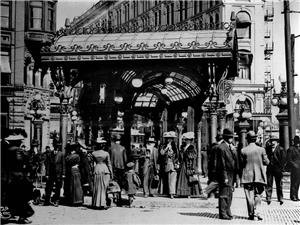On September 23, 1909, an underground comfort station opens in Pioneer Place, a small park located downtown in Seattle's Pioneer Square (corner of 1st Avenue and Yesler Way). The public toilets are built underground below an ornate iron and glass pergola. The comfort station is ventilated through nonstructural pillars in the pergola, which are hollow. The restrooms have marble stalls, brass fixtures, oak chairs, white-tiled walls, and terrazzo floors. These are believed to be the world's most luxurious underground toilets. After opening, they are flushed approximately 5,000 times a day; 8,000 times on Sundays when saloons are closed.
The Eighth Wonder of the World?
A 1910 article in the Seattle weekly, Pacific Builder and Engineer, described the facilities as follows:
"The man of travels will find nowhere in the Eastern hemisphere a sub-surface public comfort station equal in character to that which has recently been completed in the downtown district of Seattle; and in the United States there are very few that will be found to equal it. ... Roland W. Cotterill, secretary of the Park Board, states that the comfort station has been one of Seattle's best advertisements. He has expressed himself as surprised at both the character and geographical distribution of the inquiries he has received about it."
There were free toilets and pay toilets, with separate entrances for men and women. In the men's free room there were 10 toilets, five lavatories (wash basins), four urinals, and one sink. In the men's pay room, there were six toilets that opened with a key, five lavatories, and four sets of urinals. The women's room had nine toilets (two paid toilets opened with a key), six lavatories, and one sink. The men's and women's rooms each had an anteroom with oak chairs and a shoeshine stand. The men could purchase a cigar.
A Popular Downtown Stop
Architect Julian T. Everett designed the facility to accommodate 10,000 patrons a day. General contractor Thomas F. Flynn built it at a cost of $24,505.85.
Seattle Mayor Miller, City Councilman Weaver, and Superintendent of the Health Department Dr. J. E. Crichton petitioned the Park Board for this facility but encountered opposition from the local press. Park Commissioner Ferdinand Schmitz (b. 1861) saved the project. He announced that he would build it first, and then if people objected, he would remove it at his own expense. The underground toilets were built.
They remained in use until some time after World War II, when they were closed and capped over. The pergola and the famous Tlingit totem pole in the park above the comfort station were made national historic landmarks in 1977. On January 15, 2001, the pergola collapsed in the early morning when it was accidentally hit by a truck. After an elaborate and careful restoration financed by the firm whose truck hit the pergola, it re-opened on August 17, 2002. The sanitary toilets below remain closed.

